 |
Ballhead groundsel (or ragwort), Senecio
sphaerocephalus
Greene (left). Groundsels are also known as butterweeds or
ragworts—the latter from the ragged appearance of the flowers. This
plant's species name, sphaerocephalus means “round-headed.”
It is a common perennial in our area, blooming early in the spring while
there is snow on surrounding mountains. Because "spring" in the mountains
is relative, this plant blooms well into the summer at higher
elevations, almost to treeline. In addition to their rounded configuration
(the meaning of sphaerocephalus) they have black-tipped bracts that
cup each flowerhead. Its alternate leaves, stemmed at the base, become
much smaller and stemless as they ascend the stem.
Wooly groundsel, Senecio canus Hook.
(right) is a notably furry ("tomentose") plant that
is found from the plains to high in the mountains. it is easily
identified by its hairy leaves (Hieracium
scouleri, the westerrn hawkweed shown below is another
hairy composite that has smaller flowerheads that lack a central disk,
|
 |
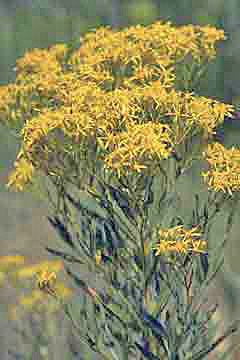 |
Butterweed groundsel, Butterweed, or Tall ragwort, Senecio
serra Hook.
(right). Butterweeds grow all over the United States. They
bloom abundantly in our area in recently moist meadows from midsummer on,
depending on elevation Many small flowers arise from a myriad of stemlets.
Lanceolate leaves without stemlets attach directly to the plant's stems.
The individual blooms have a ragged appearance, common to senecios in general.
The species name, serra, means "toothed" or "serrated," referring
to the leaves, {although, confusingly, the leaves in some plants are
smooth-edged).
Arrow-leaf ragwort (or groundsel), Senecio
triangularis Hook., (right)
is a somewhat similar, although less common plant with large, basal,
triangular leaves. These tend to become narrow as they ascend the stem. They
may be smooth-edged, or toothed. This plant not uncommonly is seen along
stream banks. The plant is widespread in the West, growing
at mid- to higher elevations. |
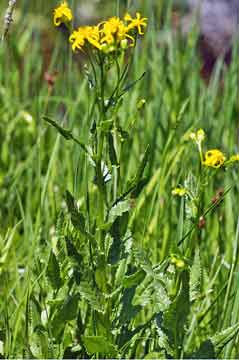 |
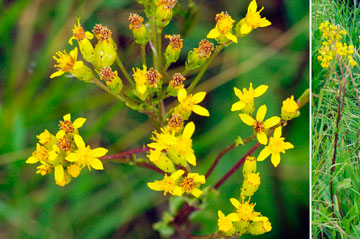 |
Alkali-marsh ragwort, Senecio
hydrophilus Nutt. (left).
The alkali-marsh ragwort grows, as its name suggests, on wet ground,
as in water-meadows. It takes a tall plant to bring its flowerheads even
with the tops of surrounding grass, and such is this one. This ragwort is
identified by its wet surroundings, its dark stems and the few-petaled, ragged
flowerheads (hence "ragwort)"that are common to the genus. The plant is found
throughout the west, excepting the southwestern states.
Rocky alpine groundsel, Packera
werneriifolia (A.
Gray) W. A. Weber & A. Löve (right). Many plants,
previously classified as senecios have been reclassified to genus
Packera (the name honors botanist John G. Packer [1929- ] of
the University of Alberta.). The little plant, shown on the
right, is quite at home on alpine tundra. It was classified as a Senecio
until recently. Its flowerhead is rayed, although the rays are extremely
small. Its ovoid gray-green leaves and the purplish involucres--made up of
leaves that cup the flower parts--help to identify the plant.
|
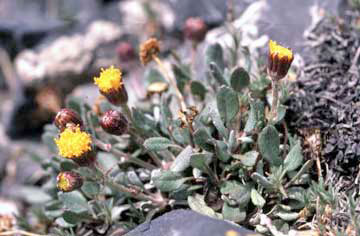 |
 |
Dwarf arctic groundsel, Packera
subnuda (DC.) D. V. Trock
& T. M. Barkley (left). This little ragwort (formerly
classified as Senecio cymbalaroides) is a tiny, prostrate ,late-blooming
alpine plant. Tiny toothed leaves and few-rayed flowerheads help with
identification. The species name, subnuda, refers to its nearly leafless
stem (not well shown in the illustration). It grows in the
Northwest, California, Wyoming and north to the arctic islands of
Canada
Buek's groundsel, Packera
cymbalaria (Pursh)
W. A. Weber & A. Love (right). This high altitude
bog and moist-meadow plant's naked stem and roundish serrated leaves resemble
somewhat those of the dwarf arctic groundsel (left), so it also was classified
as Senecio cymbalaroides. Both plants have been reclassified recently.
This plant's flowerhead and basal leaves are small and separated by a
disproportionately long and slender stem--a configuration that makes photography
difficult. It is naive to Idaho, Washington, Montana, the
contiguous Canadian provinces, north to Alaska. A disjunct popularion grows
in Canada's eastern provinces. |
 |
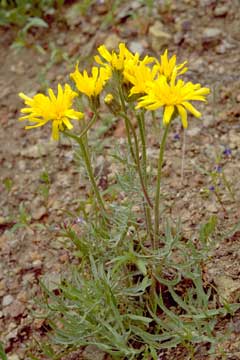 |
Low hawksbeard, Crepis
modocensis Greene (left). The low
hawksbeard has only ray flowers. Its leaves , and the leaves of the genus
in general, are deeply incised, long-stemmed, and pinnate (feather-like).
The Greek word krepis means “sandal,” apparently used by
Theophrastus for a similar plant. The name, modocensis, refers
to Modoc County in California. Other Crepis species also grow in Idaho;
the form of their deeply serrated leaves helps to identify the plants
Western hawksbeard, Crepis occidentalis
Nuttall var occidentalis
(right) is a low, foothills plant with
large flowers. Its foliage in common with other hawksbeards, is a hairy
grayish-green. The plants are variable, and four varieties are
recognized |
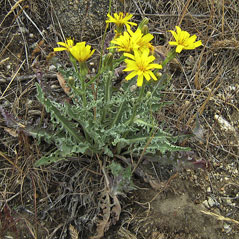 |
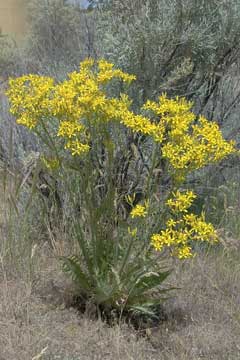 |
Longleaf Hawksbeard, Crepis
acuminata Nuttall
(left) is another foothills species, and
the tallest of our hawkweeds. It has a tendency to interbreed with Crepis
modocensis. The hybrid is recognized as Crepis
intermedia.
Western Hawkweed, Hieracium scouleri
Hook. (right: formerly
Hieracium cynoglossoides) has half inch wide flowerheads
that are without disk florets. All parts of the plant save the flowerhead
itself are notably hairy and the sap is milky—both help to identify
the plant. It is common, blooming from mid-summer on as high as the subalpine
zone. The name hieraceum was derived from the Greek hierax
for “hawk.” John Scouler (1804-1871) was a naturalist who visited
the Northwest briefly in 1825-6. |
 |
 |
Stemless goldenweed, Stenotus
acaulis (Nutt.)
Nutt. (left). Although the stemless goldenweed was included
in the genus Haplopappus for many decades, it has recently been returned
to Thomas Nuttall’s original classification (according to botanical
nomenclatural rules, the earliest published name always has priority). He
apparently derived the generic name Stenotus from the Greek
stenos, a word that means “narrow,” probably for the shape
of its stemless (acaulis) leaves. The plant grows from foothills to
alpine tundra..
Woolly goldenweed, Stenotus
lanuginosus (A. Gray) Greene var.
andersonii (Rydb.) C. A. Morse (right). The woolly
goldenweed (formerly Haplopappus lanuginosus var. andersonii)
is commonly seen in our mountains from montane to the subalpine zones growing,
typically on rocky or gravelly soil. The plant is characterized
by basally clustered, soft, narrow, rather hairy leaves. The showy flowerhead
has a prominent disk and wide, deep-yellow rays. |
 |
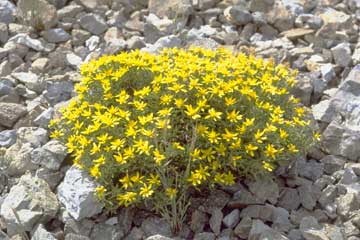 |
Shrubby goldenweed, Ericameria
suffruticosa (Nutt.) G. L. Nesom.
The shrubby goldenweed (formerly Haplopappus
suffruticosus) is a summer-blooming plant that grows in tight shrubby
clusters (left) at high elevations, sometimes turning barren, south-facing
slopes close to treeline a bright yellow The flowerheads (right) are few-rayed
(5-9) with bristly central disks. Crisp-edged leaves are covered with fine
hair. The plants have a very strong, but not unpleasant aromatic odor that
fills the air even before the plants have bloomed. Shrubby goldenweeds grow
in Idaho, and the nearby states of Oregon, California, Nevada, Wyoming and
Montana. |
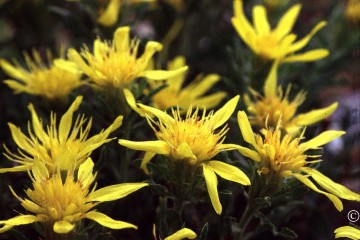 |
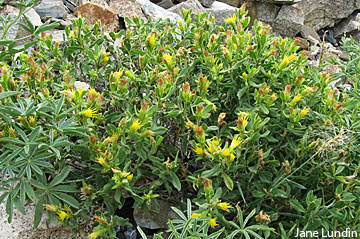 |
White-stem goldenweed, Ericameria
discoidea (Nutt.) Nesom
(left, right). The white-stem goldenweed--its common name
comes from the plant's light-colored stem--also grows at high elevations,
on rocky soil and talus slopes. This and the shrubby golden weed
(above) are quite similar; both grow in low, shrubby clusters. The main
difference between the plants is obvious in the illustrations; this one has
only disk florets (discoidea). It lacks the ray-flowers that its near
relative, the shrubby goldenweed, has. Its distribution is similar, although,
unlike the shrubby goldenweed, the white-stem species also grows in Utah
and Colorado
|
 |
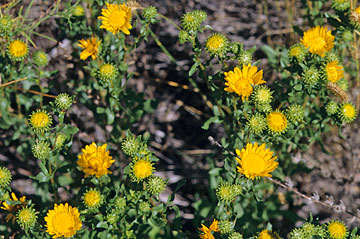 |
Curly cup gumweed, Grindelia
squarrosa (Pursh) Dunal
(left,
right) is an odd plant because
its flower buds contain a whitish, viscous, resinous fluid. Native Americans
used the resin to treat skin conditions, and respiratory problems. The leaves
were used for tea, and the buds were chewed as gum. The Latin species
name, squarrosa, means “bent at right angles,” referring
to bracts that form the resin-filled “curlycups” cupping the
flowerheads. The bracts turn sharply outward explaining the plant's common
and scientific names. Gumweeds grow along our trails and mountain roadsides,
often in great numbers, blooming from mid- to late summer. The name Grindelia
honors David Hieronymus Grindel (1776-1836) a Russian botanist. Lewis and
Clark collected another variety of this plant in present day Nebraska on
August 17, 1804. Three varieties are recognized, together
their distribution covers the United States (excepting the deep south) and
almost all of Canada. |
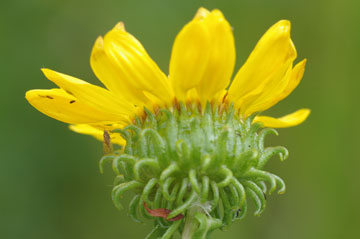 |
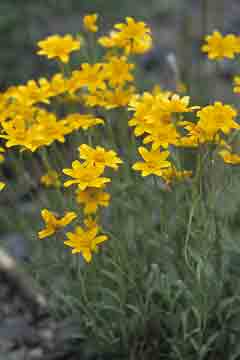 |
Common eriophyllum, Eriophyllum
lanatum (Pursh) J. Forbes
var. integrifolium (Hook.) Smiley
(left). Various common names including “woolly
sunflower” and "Oregon gold" have been suggested for this attractive
composite, although it is usually known simply as an “eriophyllum”
(eri-OFF-illum). The leaves are variably covered with fine hairs giving them
a silvery color, explaining the species name, lanatum
(“woolly”). They grow to subalpine elevations, blooming from late
spring into the summer. Lewis and Clark saw eriophyllums growing in meadows
above their camp on the Clearwater River near present day Kamiah, Idaho,
where they gathered two specimens (of another variety) on June 6, 1806; the
plant was then unknown to science. Grindelias have minor
differences, including the number of rayflowrs and shape of their leaves,
varying from place to place throughout the West--more than a dozen varieties
are recognized.
|




















